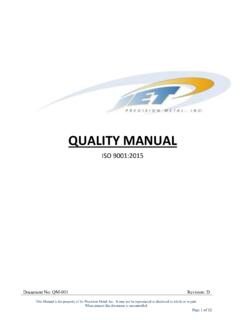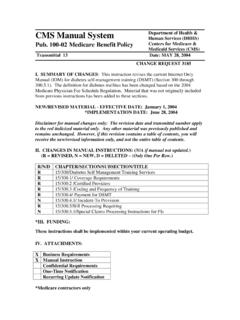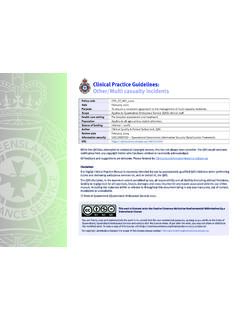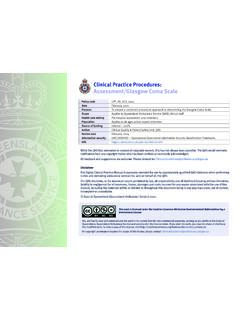Transcription of MATERIALS TESTING MANUAL - dipl.nt.gov.au
1 MATERIALS TESTING MANUAL . Originator: Philip Stacey, Approved by: Bob Pemble, Approved for Intranet Publication: Senior Project Manager, Executive Director, 4 November 2013. MATERIALS TESTING Civil Construction Controlled Document Number: Version Number: Review by: QM 0182 20 September 2014. Document uncontrolled when printed. Check DCI Intranet for controlled document. Page 1 of 129. Printed on 21/02/2014. CONTENTS. SECTIONS. SECTION 1 - CODES OF PRACTICE. SECTION 2 - SAMPLING AND TESTING SOILS. SECTION 3 - SAMPLING AND TESTING AGGREGATE. SECTION 4 - SAMPLING AND TESTING PAVEMENT MARKING AND.
2 TRAFFIC CONTROL DEVICES. SECTION 5 - SAMPLING AND TESTING BITUMEN AND RELATED PRODUCTS. SECTION 6 - SAMPLING AND TESTING CEMENT AND CONCRETE. SECTION 7 - PAVEMENT TESTING . SECTION 8 - AUSTRALIAN STANDARDS AND OTHER PUBLICATIONS COVERED. UNDER THE DEPARTMENT OF PLANNING AND INFRASTRUCTURE. ROADWORKS SPECIFICATION. SECTION 9 - NOT USED. SECTION 10 - NOT USED. 2|P a g e INDEX OF CODES OF PRACTICE. METHOD NO. SECTION 1 METHOD CODE OF PRACTICE PAGE NUMBER. NTCP Selection of Test Methods 2. NTCP TESTING Field Compaction for Conformance 3. NTCP Site Selection by the Stratified Random Technique 11.
3 NTCP Audit TESTING of Compaction - Joint Method 16. NTCP Registration of Asphalt Mix Designs 18. NTCP Ride quality 22. CODE OF PRACTICE NTTP SELECTION OF TEST METHODS. 1. SCOPE. This Code covers the selection of the most appropriate test method for sampling or TESTING of MATERIALS . The Northern Territory Department of Infrastructure Test Methods (NTTM) and Codes of Practice (NTCP) have been developed to clearly identify the practice to be adopted. 2. SELECTION OF TEST METHOD. The Department of Infrastructure Test Methods and Codes of Practice contained in this MATERIALS TESTING MANUAL shall take precedence over all test methods and procedures, and shall be used in conjunction with relevant Australian Standards.
4 Where tests are required which are not included in the MANUAL , the appropriate Australian Standard method shall be used. In special circumstances where tests are required which are not covered in this MANUAL or by Australian Standards, other appropriate methods may be used at the Superintendent's approval, Australian Road Research Board (ARRB). Austroads (Austroads). National Association of Australian (NAASRA). State Road Authorities British Standards Institution (BSI). American Society for TESTING MATERIALS ASTM (ASTM). 4|P a g e CODE OF PRACTICE NTTP TESTING FIELD COMPACTION FOR CONFORMANCE.
5 1. SCOPE. This Code sets down the procedures to be followed when carrying out acceptance TESTING of field compaction of pavement MATERIALS , earthworks and backfill. This Code takes precedence over Australian Standards. For work being carried out under contract, this Code must be read in conjunction with the particular contract specification and relevant test methods. 2. LOT TESTING . Test Lot Bounds Test lot bounds shall be determined by the contractor in accordance with the specification. Areas within 150mm of the edges of construction, or within 5 metres of lateral construction joints should be excluded from the lot.
6 Soils and pavement MATERIALS which do not appear essentially homogenous and are not uniform in terms of maximum size and particle size distribution may be included in the lot provided that laboratory compaction tests are performed on material from each field density test site ie one for one TESTING . Selection of a Lot It is the responsibility of the Superintendent or, on quality system contracts, the contractor, to define the bounds of the lot, to designate any areas to be excluded from the lot on the basis of appearance or test-rolling response and to nominate any areas, excluded under Section which is required to be assessed separately.
7 Selection of Test Sites within a Lot The validity of lot TESTING depends on there being no bias associated with the selection of test sites. Prior to the start of the selection process, every point in the lot must have an equal chance of being selected. The method for selecting the test sites is covered in NTCP - Site Selection by the Stratified Random Technique. 3. FIELD DENSITY MEASUREMENT. Different methods shall not be used in the determination of field densities within a lot. The following test methods are currently applicable: 5|P a g e CODE OF PRACTICE NTTP Test Methods Department of Infrastructure Test Methods and Codes of Practice.
8 Australian Standard Test Methods: - Determination of the Moisture Content of a Soil - Oven Drying Method;. - Determination of the Dry Density Moisture Content Relation of a Soil Using Modified Compactive Effort;. - Dry Density Ratio, Moisture Ratio and Moisture Variation;. - Assignment of Maximum Dry Density and Optimum Moisture Content Values;. - Determination of Field Moisture Content and Field Dry Density of a Soil Method Using a Nuclear Surface Moisture - Density Gauge - Direct Transmission Mode;. AS - Nuclear Surface Moisture Density Gauges Calibration Using Standards Blocks.
9 The job specification must be checked to see whether or not acceptance is based on TESTING of the work in lots. Selection of Test Methods Nuclear gauges shall be used for the determination of field density. When environmental conditions are such that the results from the nuclear gauge could be affected, at the superintendent's approval alternative methods may be considered. Whenever practicable, the same method shall be used for all field density TESTING carried out on a given material on any one project. Results from different modes of operation are not comparable. Nuclear Gauge TESTING For earthworks and pavement MATERIALS , nuclear gauge TESTING shall be performed in accordance with AS Depth of TESTING The depth over which density TESTING is carried out by Nuclear Gauge in the direct transmission mode, shall be with the probe set at a point equal to, or as near as practicable to the nominal layer thickness.
10 NOTE: Should the probe be inserted to a depth greater than the nominal layer thickness the test must be repeated. This can be checked when collecting samples for moisture contents for processing by 6|P a g e CODE OF PRACTICE NTTP Moisture Content Field moisture content may be determined by either a nuclear gauge in accordance with AS , using offsets determined in accordance with AS , when applicable, or AS When the moisture content is determined by AS , the sample shall be taken from between the source rod and the detector to the depth of the probe. The sides of the hole shall be reasonably vertical.













